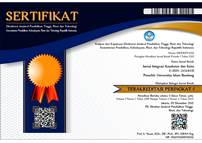Scoping Review: Pengaruh Paparan Asap Rokok terhadap Kadar Kotinin dalam Tubuh Perokok Pasif
Abstract
Perokok pasif adalah orang tidak merokok, namun ikut menghirup asap rokok dari orang-orang merokok di sekitarnya. Produk yang dihirup dihasilkan dari asap utama yang dihembuskan dan asap dari ujung rokok yang masih membara. Perokok pasif memiliki kandungan nikotin yang akan dimetabolisme menjadi kotinin menggunakan enzim CYP2A6 dan didistribusikan dalam tubuh perokok pasif seperti darah, saliva, dan urine. Hasil metabolisme mengakibatkan peningkatan kadar kotinin dalam tubuh perokok pasif. Dampak peningkatan kadar kotinin menyebabkan gangguan kesehatan seperti lung cancer, oral cancer, asthma, chronic obstructive pulmonary disease (COPD), dan coronary heart disease. Tujuan penelitian ini menganalisis pengaruh paparan asap rokok terhadap kadar kotinin dalam tubuh perokok pasif. Penelitian dilakukan dengan metode scoping review dengan subjek artikel ilmiah nasional dan internasional yang memenuhi kriteria kelayakan (eligible). Hasil pada penelitian ini diambil dari artikel yang akan dinilai secara PICOS, yaitu Population: anak-anak perokok pasif yang terdapat pada artikel jurnal, Intervention/Exposure: asap rokok sekunder, Comparison: anak-anak yang tidak tinggal dengan perokok, Outcome: kadar kotinin dalam tubuh perokok pasif, Study: RCT, clinical trial, dan cross-sectional. Artikel yang memenuhi kelayakan (eligible) ada enam artikel. Simpulan penelitian ini menunjukkan bahwa pada perokok pasif menunjukkan kadar kotinin yang meningkat.
SCOPING REVIEW: THE EFFECT OF CIGARETTE SMOKE EXPOSURE ON COTININE LEVELS IN THE BODY OF PASSIVE SMOKERS
Passive smokers are people who do not smoke but also inhale smoke from smoking people around them. Secondhand smoke has produced from the smoke exhaled by smokers and the smoke from the still-smoldering end of the cigarette. Passive smokers who contain nicotine will be metabolized into cotinine by the CYP2A6 enzymes and will be distributed through blood, saliva, and urine into the body of passive smokers. This metabolism results in an increase in cotinine levels in the body of passive smokers. The impact of increasing cotinine levels causes health problems such as lung cancer, oral cancer, asthma, chronic obstructive pulmonary disease (COPD), and coronary heart disease. The research objective was to analyze the effect of cigarette smoke on cotinine levels in the body of passive smokers. The research was conducted using the scoping review method with the subjects of national and international scientific articles that meet the eligibility criteria (eligible). The results of this study were articles assessed using PICOS, namely Population: passive smoking listed in journal articles, Intervention/Exposure: secondary cigarette smoke, Comparison: children who do not live with smokers, Outcome: cotinine levels in passive smokers, Studies (RCT, clinical trial, and cross-sectional). Six articles meet the eligibility (eligible). The conclusions of this study indicate that passive smokers show increased cotinine levels.
Keywords
Full Text:
PDFReferences
Leone A, Landini L, Leone A. What is tobacco smoke? Sociocultural dimensions of the association with cardiovascular risk. Curr Pharm Des. 2010;16(23):2510–7.
Adhami N, Chen Y, Martins-Green M. Biomarkers of disease can be detected in mice as early as 4 weeks after initiation of exposure to third-hand smoke levels equivalent to those found in homes of smokers. Clin Sci (Lond). 2017;131(19):2409–26.
Petrick LM, Svidovsky A, Dubowski Y. Thirdhand smoke: heterogeneous oxidation of nicotine and secondary aerosol formation in the indoor environment. Environ Sci Technol. 2011;45(1):328–33.
Ferrante G, Simoni M, Cibella F, Ferrara F, Liotta G, Malizia V, dkk. Third-hand smoke exposure and health hazards in children. Monaldi Arch Chest Dis. 2013;79(1):38–43.
Cheng CY, Huang SS, Yang CM, Tang KT, Yao DJ. Detection of third-hand smoke on clothing fibers with a surface acoustic wave gas sensor. Biomicrofluidics. 2016;10(1):011907.
Badan Penelitian dan Pengembangan Kesehatan Kementerian Kesehatan Republik Indonesia. Laporan nasional Riskesdas 2018. Jakarta: Lembaga Penerbit Badan Penelitian dan Pengembangan Kesehatan; 2019.
Karaconji BI. Facts about nicotine toxicity. Arh Hig Rada Toksikol. 2005;56(4):363–71.
Raja M, Garg A, Yadav P, Jha K, Handa S. Diagnostic methods for detection of cotinine level in tobacco users: a review. J Clin Diagn Res. 2016;10(3):ZE04–6.
Tzatzarakis MN, Vardavas CI, Terzi I, Kavalakis M, Kokkinakis M, Liesivuori J, dkk. Hair nicotine/cotinine concentrations as a method of monitoring exposure to tobacco smoke among infants and adults. Hum Exp Toxicol. 2012;31(3):258–65.
Avila-Tang E, Al-Delaimy WK, Ashley DL, Benowitz N, Bernert JT, Kim S, dkk. Assessing secondhand smoke using biological markers. Tob Control. 2013;22(3):164–71.
Drehmer JE, Walters BH, Nabi-Burza E, Winickoff JP. Guidance for the clinical management of thirdhand smoke exposure in the child health care setting. J Clin Outcomes Manag. 2017;24(12):551–9.
Sleiman M, Gundel LA, Pankow JF, Jacob P 3rd, Singer BC, Destaillats H. Formation of carcinogens indoors by surface-mediated reactions of nicotine with nitrous acid, leading to potential thirdhand smoke hazards. Proc Natl Acad Sci USA. 2010;107(15):6576–81.
Jacob P 3rd, Benowitz NL, Destaillats H, Gundel L, Hang B, Martins-Green M, dkk. Thirdhand smoke: new evidence, challenges, and future directions. Chem Res Toxicol. 2017;30(1):270–94.
Abidin EZ, Semple S, Omar A, Rahman HA, Turner SW, Ayres JG. A survey of schoolchildren’s exposure to secondhand smoke in Malaysia. BMC Public Health. 2011;11:634.
Hovell MF, Wahlgren DR, Liles S, Jones JA, Hughes SC, Matt GE, et al. Providing coaching and cotinine results to preteens to reduce their secondhand smoke exposure: a randomized trial. Chest. 2011;140(3):681–9.
Wang MP, Suen YN, Wong BYM, Li WHC, Koh DSQ, Lam TH, dkk. Paternal smoking and maternal protective behaviors at home on infant’s saliva cotinine levels. Pediatr Res. 2018;83(5):936–42.
Jarvis MJ, Sims M, Gilmore A, Mindell J. Impact of smoke-free legislation on children’s exposure to secondhand smoke: cotinine data from the Health Survey for England. Tob Control. 2011;21(1):18–23.
Luk TT, Wang MP, Suen YN, Koh DS quee, Lam TH, Chan SS. Early childhood exposure to secondhand smoke and behavioural problems in preschoolers. Sci Rep. 2018;8(1):15434.
Siddiqi K, Huque R, Kanaan M, Ahmed F, Ferdous T, Shah S, et al. Children learning about secondhand smoke (CLASS II): a pilot cluster randomized controlled trial. Nicotine Tob Res. 2019;21(5):670–7.
DOI: https://doi.org/10.29313/jiks.v3i2.7449
Refbacks
- There are currently no refbacks.
Jurnal Integrasi Kesehatan dan Sains is licensed under a Creative Commons Attribution-NonCommercial-ShareAlike 4.0 International License.







.png)
_(1).png)




















